Surf & Turf: Uncovering The Meat Industry
Something Fishy About It: Where Does Your Salmon Come From?
Sofia Godinez

As I stood in the seafood section mesmerized by the wide variety of fish, I noticed several types of salmon and very different prices. I couldn’t help but ask myself, why are the prices so different? Which salmon should I buy?
My first thought is to question where the salmon comes from. However, most people don’t think twice about where their salmon comes from, they just assume it’s healthy for them. Especially when the labels emphasize that the salmon is high in omega-3s. Therefore, since the consumer might not understand the difference in salmon, they’ll most likely opt for the cheaper option, because who doesn’t want to save money right? It is no secret that the food we eat doesn’t always come from the best places, even the food that is supposed to come straight from the ocean. Salmon can be fished from the ocean and marketed as wild. However, it can also be raised on a farm and marketed as farmed. What are the differences?
There are actually a lot of differences between the two and it is extremely worthwhile to be educated on what they are. After learning more about them, maybe the next time you’re at the store you’ll think twice about your choice of salmon and you can make an informed, healthier and more ethical decision, even if that means buying the more expensive salmon.
“Two-thirds of the U.S.’s salmon comes from farms and the majority of those farms are in Chile, Norway and Canada.”
Let’s start off with some basic, but important, facts. Coho, Chum, Chinook, Sockeye, and Pink salmon typically come from wild fisheries in the Pacific, while Atlantic salmon is the type that usually comes from commercial fish farms (Kelly, 2019). Two-thirds of the U.S.’s salmon comes from farms and the majority of those farms are in Chile, Norway and Canada, but there is also a small amount that is sourced from Maine, Washington and Alaska (Kelly, 2019). Therefore, only one-third of the salmon in the U.S. is wild-caught. That means that most of our “seafood” isn’t actually from the sea…
So, what does this really mean? Let’s dive in deeper and compare the two types of salmon to see what the major differences are.
Farmed Salmon
According to Healthline, half a fillet of farmed salmon is around 412 calories with 27 grams of fat and six grams of saturated fat. It contains the two main types of polyunsaturated fats, omega-3 and omega-6 fatty acids. They are termed essential fatty acids because they play important roles in your body and are needed in your diet. However, it is important to strike the right balance between the two. Farmed salmon has more omega-3s and omega-6s than wild salmon. However, the imbalanced ratio between the two makes the total fat content three times as much as wild salmon (Leech, 2018). So despite these fatty acids being an essential part of your diet, their abundance in farmed salmon can cause overconsumption and potentially lead to diseases such as type 2 diabetes and obesity (Wild for Salmon, 2020). Therefore, do we want more fat in our diet?

To give farmed salmon its pink color, additives are needed to turn its naturally white and gray flesh into a pink flesh, however, the color is still lighter than wild salmon. Wild salmon tends to be a deep red/orange and because it is less fatty, the stripes of fat are less visible or nonexistent. To give the fish this color, most farmers supplement the salmon’s food with carotenoids, pigments found in plants, algae, and photosynthetic bacteria. The carotenoids farmers use are either taken from green algae, ground-up from crustaceans or synthetically created in a lab. These additives account for about 20% of the cost of feeding the fish (Kelly, 2019). Overall, farmed salmon are fed a processed diet of fatty-high protein, often synthetic, feed (Wild for Salmon, 2020).
“The use of antibiotics in fish can also be a health concern for consumers because traces of antibiotics can cause allergic reactions as well as harm your gut bacteria and make you more susceptible to bacterial infections.”
Farmed fish are generally more susceptible to infections and disease (Leech, 2018). Therefore, antibiotics are commonly used to control and treat the diseases. This then affects the environment because the antibiotics enter the natural environment and contaminate wild seafood. They can disrupt the ecosystem by threatening to spread pathogens, such as sea lice, to the naturally healthy wild salmon population (Wild for Salmon, 2020). The Center for Food Safety shares that a study found wild fish had drug residues that exceeded the FDA safety levels (CFS, 2020). The use of antibiotics in fish can also be a health concern for consumers because traces of antibiotics can cause allergic reactions as well as harm your gut bacteria and make you more susceptible to bacterial infections. In developing countries, the use of antibiotics is poorly regulated. However, the main countries that farm salmon, such as Norway and Canada, have good regulatory frameworks, and the use of antibiotics is strictly regulated. Despite this, Chile, another major producer of farmed salmon, is one of the biggest users of antibiotics in the livestock industry (Kelly, 2019).
Farmed salmon also tends to be higher in contaminants. The fish ingest these harmful contaminants from the food they eat and the water they swim in. Some of the contaminants found in the fish include polychlorinated biphenyls (PCBs), dioxins and chlorinated pesticides. PCBs have been strongly associated with cancer and other health problems (Leech, 2018).
“Farm raising salmon prevents the fish from traveling like wild animals.”
Farm raising salmon prevents the fish from traveling like wild animals. The salmon are placed in very small and crowded pens, stopping them from swimming very far or at all (Chricton-Stuart, 2018). These pens are submerged in lakes, ponds, and sometimes even areas in the ocean. Because they are so small, the salmon’s natural instinct to swim long distances is altered. On the other hand, wild salmon are known to have a “wandering lifestyle” and can travel hundreds of miles, which helps keep them lean and possess pure muscle, making them the healthier option (Wild for Salmon, 2020).
An easy way to spot farmed salmon at grocery stores is to look for labels that say “Atlantic salmon” or “farm-raised.”
Wild Salmon
According to Healthline, half a fillet of wild salmon is around 281 calories, has 13 grams of fat and 1.9 grams of saturated fat (Leech, 2018). Although wild salmon generally has less omega-3s than farmed salmon, it is higher in minerals, including potassium, zinc and iron. It also has less total fat. Chinook salmon has the highest fat and omega-3s of the wild salmon, this is because fish raised in colder environments tend to have more fatty tissue (Kelly, 2019). Chinook salmon live in the upper reaches of the Pacific Ocean. Their range includes the coasts of Alaska, Western Canada, Oregon, Washington and northern California (The National Wildlife Federation, 2020). Wild salmon is a deep orange-red color, which is caused by the natural compound of carotenoids. As I mentioned earlier, these compounds are found in plants and algae. Wild salmon mostly eat small invertebrates in the ocean, where they naturally receive carotenoids. An easy way to know if salmon is wild is to look for labels that say “Pacific salmon” or “wild-caught.”
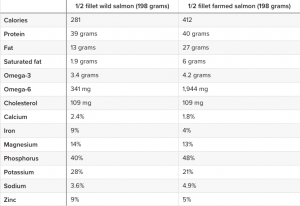
When it comes to the difference in flavor, everyone has a different opinion. There is no right or wrong answer, and your opinion might differ from others. However, I have personally felt the difference in flavor between the two, and after trying wild-caught salmon, I have found it nearly impossible to go back to eating farmed salmon! Wild salmon tends to have a “stronger” flavor, while the farmed salmon is “lighter” and sometimes doesn’t really taste like salmon. I have also found the flavor of wild salmon to be more consistent.
Labels
Reading and understanding labels can be confusing at times. Therefore, it is important to understand the differences in order to help you make an informed decision when shopping for salmon at the store. Some common and important terms to know other than Pacific and Atlantic salmon, as well as wild-caught and farm-raised, which we’ve already discussed, include the following. An article from Cooking Light explains them as:
Troll-caught: this means that the salmon is wild and that it is very sustainable because it was caught on a hook-and-line method, which usually makes it more expensive.
Sustainably-farmed: this means that the salmon is farm-raised but they were raised in tanks, not in cases or pens in the open waters. This means there is less of a chance of contamination or parasite infection, that the fish had more room to swim and that it lived in a cleaner environment.
Organic: there are currently no guidelines for USDA organic so ignore anything that might say otherwise.
Fresh: similar to organic labels, this is irrelevant.
Color-added: this label only concerns farmed salmon, as we talked about earlier, farmed salmon needs additives for the pink color (Laseter, 2017).
Pricing
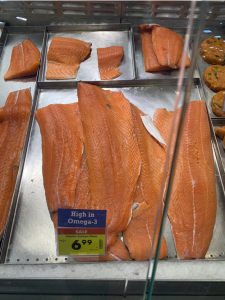
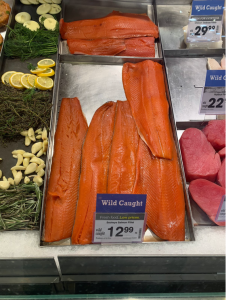
As you can see here, the wild-caught salmon at the Kroger in Bloomington, Ind. is twice the cost of the farmed salmon. The farmed salmon is $7.99/lb (or $6.99/lb with a Kroger card) while wild salmon is $12.99/lb. We can also see how the wild-caught salmon says it is a “Sockeye Salmon Fillet” and that it is a product of the U.S. The farmed salmon says “Atlantic Salmon Fillet” and mentions that it is high in omega-3s. The packaged farmed salmon (not pictured) had labels that said “Atlantic fillet fresh farm-raised,” “color added,” and “farmed raised in Chile.” Overall, the difference in color between the salmon is very clear here.
Sometimes there are a lot of labels used in one package and that can be very confusing and even misleading at times. Therefore, it is helpful to know what the different labels are and what the terms mean.

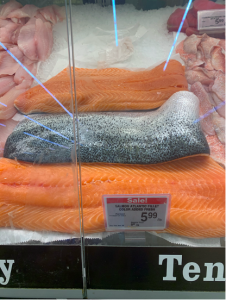
At the Jewel Osco in Naperville, Ill. There was only frozen wild salmon. This package (not pictured) cost $6.99 and it was 16 oz. The packaging labeled the brand and product as the “responsible choice.” The farmed salmon was not frozen and you could either get a large fillet for $5.99/lb or a six-ounce portion for $5.99 each. Once again, the farmed salmon was from Chile and the labels said “farmed” and “Atlantic” as well as “color added.” Here, it was hard to notice the difference in color between the two because the wild salmon was individually packaged and frozen. However, you can see how the farmed salmon has a vivid light pink/orange color. At this grocery store, the difference in price between the two wasn’t a lot, but the wild salmon was still slightly more expensive.
In general, wild salmon is more expensive than farmed salmon. So, is it worth it? When you buy wild salmon, you can be sure that the fish was not fed any antibiotics or color additives. You also know that this fish was free to live as a normal animal and traveled as it should. Wild salmon might not have as many omega-3s as farmed salmon, but it is free from contaminants and has less total fat. Therefore, the difference in price is supported by this and might be worth it.
“Wild salmon might not have as many omega-3s as farmed salmon, but it is free from contaminants and has less total fat.”
So what about restaurants? It is quite popular to order seafood when you go out to dinner because you most often want to splurge a little and eat something different from what you normally eat and cook at home. However, it is still important to keep all of this in mind when you want to order salmon at a restaurant. If the menu doesn’t already indicate where the seafood is sourced from, don’t be afraid to ask! The answer might surprise you. Sometimes, the price of the salmon can also help give away the answer.
The Bottom Line
Not knowing the differences between farmed and wild salmon, and what all the labels mean, could be holding you back from making an informed decision. That is why it is extremely important to be aware of all the facts before getting salmon at the grocery store or in a restaurant. In recent years, we have started to care more about where our food comes from. However, there hasn’t been a huge focus on seafood. Therefore, the truth is still being uncovered and we should keep working to pull back the veil and place pressure on the people in charge.
“The truth is still being uncovered and we should keep working to pull back the veil and place pressure on the people in charge.”
From an ethical and environmental perspective, wild salmon is the best option. Wild salmon is also typically nutritionally better. Therefore, by buying wild salmon, you are supporting and encouraging the best ethical and environmental practices, in addition to eating what’s healthiest for you. So despite the difference in price, making the switch to wild-caught salmon is an encouraged practice and a shift that consumers should start making for the benefit of both the environment and their own health.
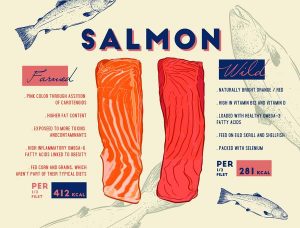
References
Center for Food Safety. (2020). Issues: Aquaculture. Retrieved from Center for Food Safety: www.centerforfoodsafety.org/issues/312/aquaculture/human-health-risks.
Chricton-Stuart, Cathleen. (2018). Wild vs. Farmed Salmon: What’s the Difference? Retrieved from Medical News Today: www.medicalnewstoday.com/articles/322847.
Dent, Diane. (2016, January 20). Salmon…..Farm Raised vs. Wild Caught. Retrieved from Diane Dent Total Wellness: dianedenttotalwellness.com/blog/2016/1/20/salmonfarm-raised-vs-wild-caught.
Kelly, Debra. (2019, February 27). The Truth about Farmed Salmon vs. Wild Salmon. Retrieved from Mashed: www.mashed.com/146396/the-truth-about-farmed-salmon-vs-wild-salmon/.
Laseter, Elizabeth. (2017, June 8). Get Schooled: How to Buy the Best Salmon at the Grocery Store. Retrieved from Cooking Light: www.cookinglight.com/eating-smart/smart-choices/how-to-buy-the-best-salmon-at-the-grocery-store.
Leech, Joe. (2018, November 8). Wild vs Farmed Salmon: Which Type of Salmon Is Healthier? Retrieved from Healthline: www.healthline.com/nutrition/wild-vs-farmed-salmon.
The National Wildlife Federation. (2020). Chinook Salmon. Retrieved from The National Wildlife Federation: https://www.nwf.org/Educational-Resources/Wildlife-Guide/Fish/Chinook-Salmon
The Wild Salmon Co. (2020). Local Pick Up. Retrieved from The Wild Salmon Co.: www.thewildsalmonco.com/local-pick-up.html.
Wild for Salmon. (2020, June 17). Wild Caught Salmon vs. Farm Raised Salmon: Which Is Better? Retrieved from Wild For Salmon: www.wildforsalmon.com/blogs/bristol-bay-bulletin/wild-caught-salmon-vs-farm-raised-salmon-which-is-better.
